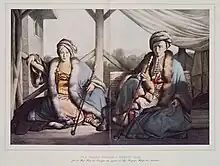Veli Pasha
Veli Pasha (Albanian: Veli Pasha; c. 1770–1822; fl. 1787–1822) was an Ottoman Albanian ruler and the second born of Ali Pasha of Ioannina of the increasingly independent Pashalik of Yanina. As an Ottoman commander, he is known for his participation in military actions against the Souliotes, the Septinsular Republic, and the Serbian rebels. He was appointed governor of the Sanjak of Tirhala in 1787, and became Pasha of the Morea Eyalet in 1807.
Veli Pasha | |
|---|---|
| Governor of the Sanjak of Tirhala; Pasha of Morea | |
| In office 1807–1812 | |
| Personal details | |
| Born | c. 1770 |
| Died | 1822 |
| Relations | Ali Pasha (father) Muhtar Bey (great-grandfather) |
| Children | Mehmed (son) Ismail (son) |
| Parent | Ali Pasha of Ioannina |
History

A member of the Meçohysaj clan, Veli was the second son of Ali Pasha and his wife Emine, the daughter of Kaplan Pasha of Gjirokastër.[1][2] Veli was a well-educated man and fluent in Albanian, Greek, Turkish and Italian. In 1787 or 1788, following his father's conquest of Ioannina and formation of the Pashalik of Yanina, a 17-year-old Veli was appointed by Ali as ruler of the Sanjak of Trikala with the title Pasha of Trikala. He married Zeivenie, a daughter of Ibrahim Pasha of Berat, in 1798. His second wife was Zybeide H. Vlora, the daughter of Sylejman Pasha.[3][4] Between 1807-1812, he ruled the Morea as Pasha.[5][6]
In 1803, his father sent him with an army to fight the Souliotes.[7] In 1806, following renewed conflict between the Ottomans and Russians, Veli Pasha was sent to attack the Septinsular Republic.[8] Veli Pasha seized Vonitsa, Preveza and Butrint.[8] Ali Pasha married Veli Pasha to his neighbour Ibrahim Pasha's daughter.[9] Veli Pasha was sent to suppress the Serbian rebels in the sanjak of Smederevo (First Serbian Uprising).
By 1804, Veli was the sanjakbey of Delvina and Beylerbey of Rumelia.[10]
By 1807, Veli Pasha had 10,000 soldiers at his disposal. Veli and his brother Muhtar attempted to convince their father to come to terms with the Sublime Porte but to no avail. Nonetheless, Ali Pasha would entrust Preveza to Veli, and Parga to Veli's eldest son Mehmet. In 1812, upon the appearance of Ottoman troops - who had arrived to subdue Ali Pasha - the Muslim population of Preveza threatened to revolt and forced Veli into the citadel. Preveza was blockaded by Turkish and Souliote forces, and the Ottoman government attempted to negotiate his surrender. In order to save his captured son Mehmet (at the pleas of Veli's other son Selim), and in return for an appointment to the Pashalik of St. John of Acre, Veli finally surrendered Preveza and deserted his father's cause.[11]
After Veli's father Ali was killed and beheaded, the head was sent to Istanbul, where it was displayed to the public on a revolving platter in a courtyard of the Sultan’s palace. When the Sultan subsequently had Ali’s three sons - including Veli - and Ali's grandson executed, Ali’s head was buried with them in the tombs outside the Selvyria gate in Istanbul.[12]
Legacy
Apart from his appointment as Pasha in multiple regions, Veli Pasha was also known for plundering multiple ancient sites. He plundered the Treasury of Atreus in Mycenae. In April, 1808, he had people dig in Mycenae; he unearthed the Tomb of Clytemnestra among multiple other tombs containing human remains and jewellery, valuable stones and gems. He also unearthed around 25 statues and a marble table. He had them all transported to Tripolitza where he is said to have thrown out the mortal remains and the gems. He sold all other findings to western travellers for 80,000.[13]
References
- Russell, Quentin; Russell, Eugenia (2017). Ali Pasha, lion of Ioannina: the remarkable life of the Balkan Napoleon. South Yorkshire, England: Pen & Sword Military. pp. 117–122. ISBN 9781473877207.
- Koçi, Dorian (2018-09-26). "Pse e rrënoi Ali Pashë Tepelena, Hormovën?" (in Albanian). Retrieved 2022-10-05.
- Byron, George Gordon (1902). The works of lord Byron. London. pp. 248–249.
{{cite book}}: CS1 maint: location missing publisher (link) - Elevating and Safeguarding Culture Using Tools of the Information Society: Dusty traces of the Muslim culture. Earthlab. p. 337. ISBN 978-960-233-187-3.
- "Ali Paşa Tepelenë". Retrieved 11 September 2021.
- "LETTER XL. TO MRS. BYRON". Retrieved 25 September 2021.
- Nicholas Charles Pappas (1982). Greeks in Russian military service in the late eighteen and early nineteenth centuries. Stanford University. pp. 257–258.
- Fleming 1999, p. 73.
- Fleming 1999, p. 96.
- Michalis N. Michael; Matthias Kappler; Eftihios Gavriel (2009). Archivum Ottomanicum. Mouton. p. 175. ISBN 9783447058995. Retrieved 25 July 2013.
When Veli Pasa was the governor of the sub-province of Delvine and derbender basbugu in 1804, he was honored with the title of Rumeli Beglerbeyi.
- Davenport, Richard Alfred (1837). The Life of Ali Pasha, of Tepeleni, Vizier of Epirus, Surnamed Aslan, Or the Lion. T. Tegg and Son. pp. 283, 374, 380, 389, 390. ISBN 9785874444174.
- Mazower, Mark (2021). The Greek Revolution: 1821 and the Making of Modern Europe (Hardback). Allen Lane. pp. 119–120. ISBN 978-0-241-00410-4.
- Iakovidis, Spyros (1978). Mykene - Epidauros - Argos - Tiryns - Nauplia. Athens: Ekdotike Athenon. p. 48.
Sources
- Fleming, Katherine Elizabeth (1999). The Muslim Bonaparte: Diplomacy and Orientalism in Ali Pasha's Greece. Princeton University Press. ISBN 0-691-00194-4.